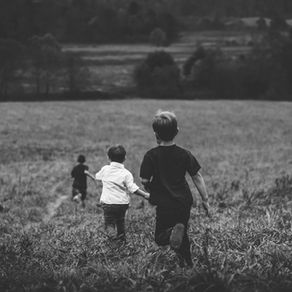- Sofie Sings

- Mar 25, 2021
- 4 min read
All throughout my childhood, my parents would take my siblings and I on mountain walks every Saturday in and around Bergen in Norway, where I grew up. Being outdoors has always been an important aspect of my life. I realise now as an adult, if I do not get outside for some fresh air and get my body moving daily, I can more easily feel tired as well as losing focus and positivity during my daily tasks. Most often all of these feelings and emotions instantly disappear when I step outside the door. Research has shown that children, benefits greatly from being outdoors, it is beneficial for improving both their mental and physical health (Harvey, et.al, 2019).
On these walks when growing up, my parents taught me to appreciate the beauty in creation. The little water streams running through the fields, the smell of fresh air just after the rain had passed, or the beams of sun coming through the woodlands. All these things I was aware of as we climbed those steep hills on our Saturday Adventure. My mum would model this by stopping and saying things like “Oh, do you hear the robin bird chirping? I wonder if she is finding food for her little ones in the nest over there?” or my dad would go “Listen, do you hear the sound from the waterfall?”.
Pause
All these observations don’t seem to require so much, and yet they do. It requires us to stop and pause, acknowledging what is around us and training our minds to be present. To use our senses as we are seeing, hearing or feeling it for the first time. It requires us calming our mind, in order to recognise the beauty that surrounds us.
So, as this is a music blog, what does all of this listening to sounds in nature have to do with anything?
I was very exposed to music in my childhood. I would join my father when going to the opera, or my mother when going to a choir concert in the local church. We would sing together every evening. But it was listening when being outdoors, that taught me to be an active listener when going to these musical events, and to appreciate the art of sound. So how can we train or inspire our children to do the same? Down below I have gathered two simple and fun ways you can try the next time you are outdoors.
The pin drops
I learned from my secondary school teacher a trick that I have used several times when teaching in school. If you’re out on a walk with your little ones, take a pin or a needle, or anything that’s small for that matter. The aim is to hear the pin drop and fall to the ground. For this it requires everyone to be still and to listen in carefully. It might take a few attempts for everyone to hear it fall to the ground, but the reward is great; now you have everyone’s attention. To continue the quiet you can whisper, “did you hear it?”. If you do already have everyone’s attention, this step is not necessary, however, a good trick to have up your sleeve.
What can you hear?
Now when everyone is listening, take this opportunity to get everyone to close their eyes and for a minute to just listen to their surroundings. If some of them are impatient, demonstrate to them that you are putting a timer on your phone for a minute and show it and then have them close their eyes. Then after a minute, have the child or children share what they heard. Now the challenge is to go after these sounds.
Younger children activity
If you have younger children, an idea for going after sounds can be to imitate the ones you hear. If you hear a car beeping, you and the little one can try to imitate the sound. Or the dog in the street, what sound does he make? Simply walking around becoming aware of these sounds are so helpful! (Shimpi, Akthar and Moore, 2013).
Older children activity
If you have older children, you can use your phone with a recorder app (most smart phones have this) walk around and try to record as many sounds as you can find. Can you hear some birds? How loud is the traffic noise, or maybe a plane? When you get home, listen to your new sound library and get a discussion going about which sound everyone liked the best. A fun thing to do as well is to have the children show their new sound library to the rest of the household.
Do let me know down below in the comment section how it went. What did you experience? How did the children react to the challenge?
_________________________________________________________________________________________
References:
Harvey, D. et,al., 2019. Psychological benefits of a biodiversity-focussed outdoor learning program for primary school children. Journal of Environmental Psychology, [online] 67. Available at: <https://www.sciencedirect.com/science/article/abs/pii/S0272494419303536> [Accessed 11 March 2021].
Shimpi, P., Akhtar, N. and Moore, C., 2013. Toddlers’ imitative learning in interactive and observational contexts: The role of age and familiarity of the model. Journal of Experimental Child Pshycology, [online] 116(2). Available at: <https://www.sciencedirect.com/science/article/pii/S0022096513001318> [Accessed 10 March 2021].
























































